Stored Food Pests
Few pest problems can be more disturbing that to
open a bag or box of baked goods and discover
that it is infested with insects. There are a
number of stored product pests that find their
way into items stored on our kitchen or pantry
shelves, and it is often difficult, if not
impossible, to tell when the item becomes
infested. Just because a box "looks" sealed does
not mean that insects cannot find their way
inside anytime before packaging, during storage
in a warehouse, retail store or even in your
home. Sometimes, pests show up in places other
than a pantry. Regardless of where we find them,
the key to solving the problem is to locate the
source of the infestation. These insects will
often attack any item made of plant material.
Typical sources of a problem are items such as:
|
whole or cracked grains (including
rice) |
dry pet food
|
|
flour, meal or similar ground grain
products |
bird seed
|
|
spices |
grass seed |
|
pasta and cereals |
some powdered soap detergents |
|
candy |
dried flowers,
potpourri, etc. |
|
powdered milk |
items stuffed with dried beans or
other plant material |
|
nuts (whole or pieces) |
tobacco products |
|
|
|
Insect pests that attack stored grains and
stored products are usually beetles or moths.
With the beetles, both the immatures (larvae)
and the adults feed on stored products. In the
case of the moths, only the larvae
(caterpillars) feed on plant products; the
adults either feed on nectar or they may not
feed at all. We also categorized these pests by
where they feed.
These insects feed primarily on
the surface of or in cracks on
their food source.
|
|
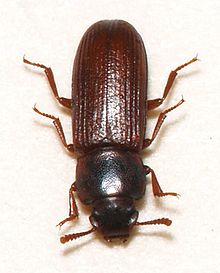 Flour
beetles
- These small (about
1/5
inch long) reddish-brown beetles
feed primarily on flour, meal and
other flour-based items. Although
they have wings, flour beetles
rarely fly. Flour
beetles
- These small (about
1/5
inch long) reddish-brown beetles
feed primarily on flour, meal and
other flour-based items. Although
they have wings, flour beetles
rarely fly.
Signs of an infestation:
larvae and/or adults on the infested
material; adults crawling on nearby
surfaces.
|
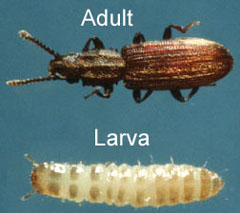 Grain
beetles
- The beetles are
smaller than flour
beetles (about
1/8
inch) and brown in
color. They are
characterized by
saw-like margins along
the area behind the
head. Aside from very
slight differences in
their appearance, the
sawtooth grain beetle
(shown at left) does not
fly, whereas the
merchant grain beetle
does. Of the two
species, the sawtooth
grain beetle is more
common. Grain
beetles
- The beetles are
smaller than flour
beetles (about
1/8
inch) and brown in
color. They are
characterized by
saw-like margins along
the area behind the
head. Aside from very
slight differences in
their appearance, the
sawtooth grain beetle
(shown at left) does not
fly, whereas the
merchant grain beetle
does. Of the two
species, the sawtooth
grain beetle is more
common.
Signs of an infestation:
larvae and/or adults on
the infested material;
adults crawling on
nearby surfaces.
|
|
 Cigarette
and Drugstore Beetles
- These brownish beetles
(about
1/5
inch long) pests are
usually found in spices
(particularly red
pepper), bread, flour,
meal, and similar
cracked, processed or
broken materials. Dry
pet foods frequently
become infested with
these insects. They
sometimes infest whole
grains, but prefer those
that have been broken
open. They will eat
almost any dried plant
material. Cigarette
and Drugstore Beetles
- These brownish beetles
(about
1/5
inch long) pests are
usually found in spices
(particularly red
pepper), bread, flour,
meal, and similar
cracked, processed or
broken materials. Dry
pet foods frequently
become infested with
these insects. They
sometimes infest whole
grains, but prefer those
that have been broken
open. They will eat
almost any dried plant
material.
Signs of an infestation:
larvae and/or adults on
the infested material;
adults crawling on
nearby surfaces.
|
|
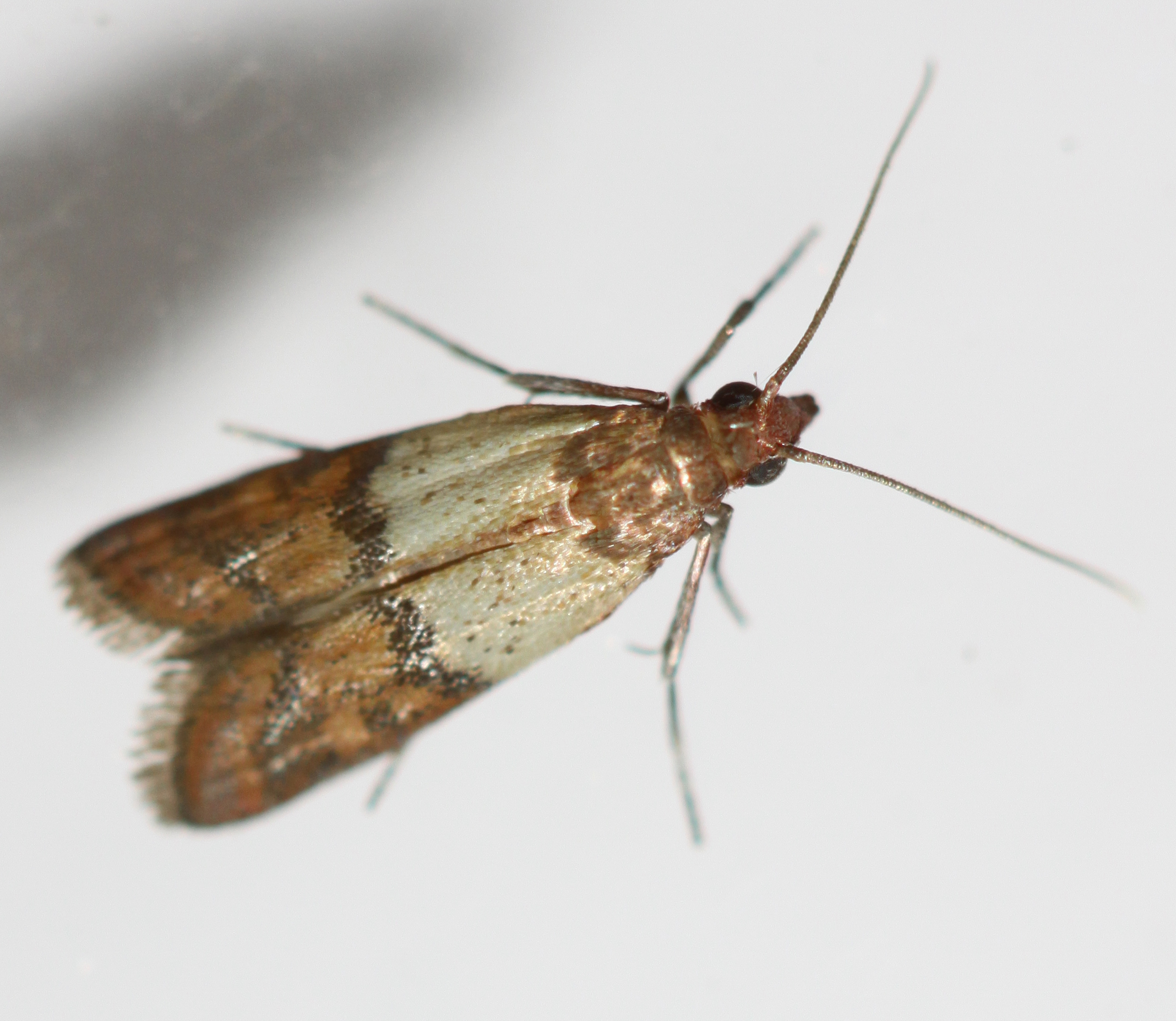 Indianmeal
moth
- This is the most
common stored
product pest found
in North Carolina.
The larvae
(immature) are
pinkish-white in
color with brownish
head capsules. The
larvae spin silk
webbing over the
surface of their
food. The adults are
small (3 Indianmeal
moth
- This is the most
common stored
product pest found
in North Carolina.
The larvae
(immature) are
pinkish-white in
color with brownish
head capsules. The
larvae spin silk
webbing over the
surface of their
food. The adults are
small (3/ 8
inch wingspread)
moths with
coppery-colored
wings. As the larvae
finish their
development, they
often crawl from
their food source
and onto walls and
ceilings.
Signs of an
infestation:
larvae or webbing on
surface of infested
material; larvae or
pupae spun into
crevices along
walls, ceilings, or
cupboards; adults
flying about the
room.
|
These insects feed
inside whole grains.
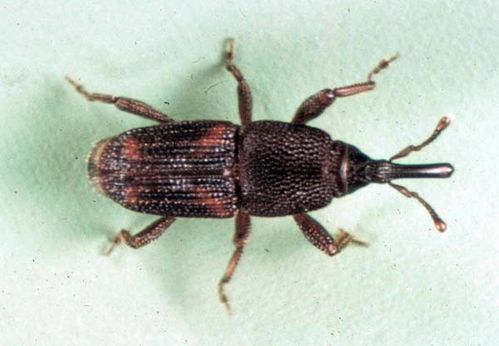 Weevils
- These beetles are
about
1/4
inch long and dark
brown in color and
have a
characteristic long
snout with chewing
mouthparts at the
tip. Like grain
borers, the female
weevil chews a small
hole in the grain
surface and deposits
her egg. The larva
tunnels into the
grain and feeds on
the kernel until it
completes its
development and
pupates inside the
kernel. The adult
weevil chews its way
out of the hollow
grain. Weevils
- These beetles are
about
1/4
inch long and dark
brown in color and
have a
characteristic long
snout with chewing
mouthparts at the
tip. Like grain
borers, the female
weevil chews a small
hole in the grain
surface and deposits
her egg. The larva
tunnels into the
grain and feeds on
the kernel until it
completes its
development and
pupates inside the
kernel. The adult
weevil chews its way
out of the hollow
grain.
Signs of an
infestation:
emergence holes in
grain; fine
sawdust-like frass
in bag or on
surface; adult
beetles crawling
around.
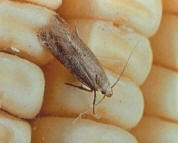 Angoumois
grain moth
- This small (3/8
inch) moth has
buff-colored wings.
The adult lays its
eggs on the surface
of the grain. The
larva chews its way
into the grain and
feeds on the kernel
before forming a
pupal case. The moth
pushes its way out. Angoumois
grain moth
- This small (3/8
inch) moth has
buff-colored wings.
The adult lays its
eggs on the surface
of the grain. The
larva chews its way
into the grain and
feeds on the kernel
before forming a
pupal case. The moth
pushes its way out.
Signs of an
infestation:
emergence holes in
grain; fine
sawdust-like frass
in bag or on
surface; moths
flying around.
|
|
|
|
|
Back |
|
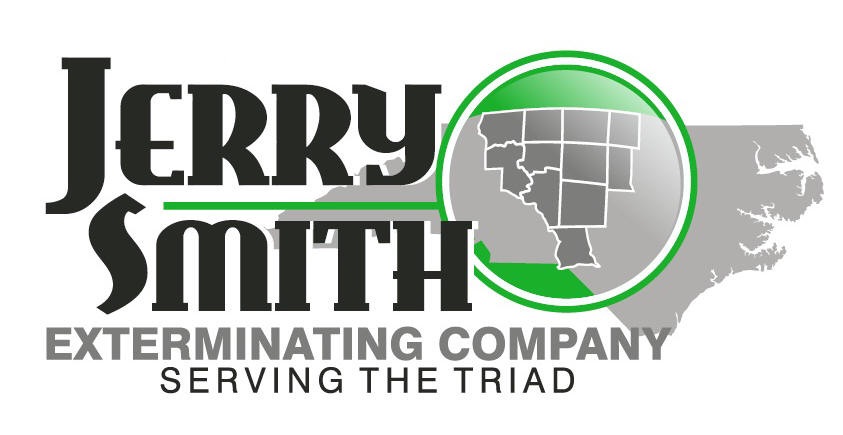
 Flour
beetles
Flour
beetles

 Indianmeal
moth
Indianmeal
moth
